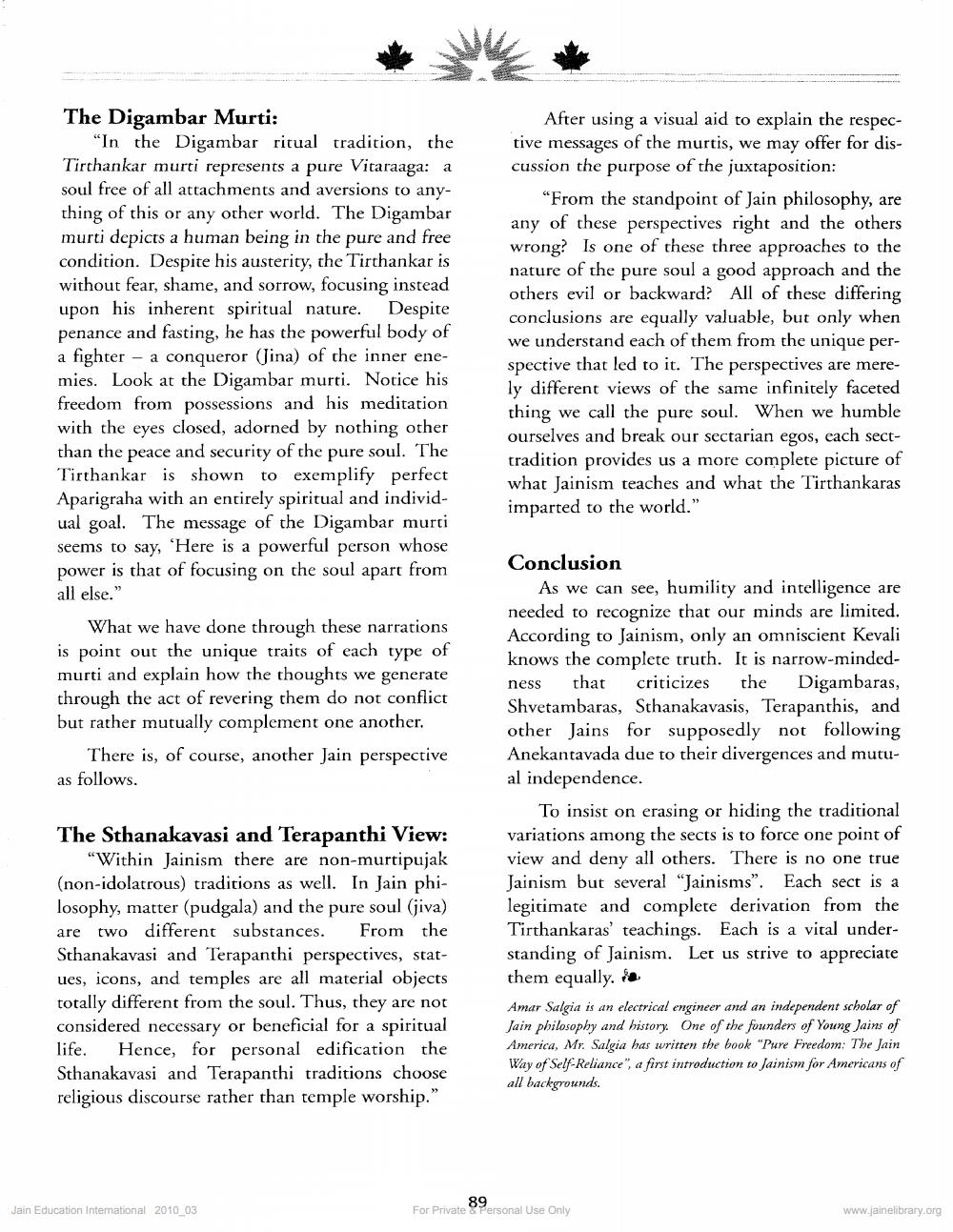________________
The Digambar Murti:
"In the Digambar ritual tradition, the Tirthankar murti represents a pure Vitaraaga: a soul free of all attachments and aversions to anything of this or any other world. The Digambar murti depicts a human being in the pure and free condition. Despite his austerity, the Tirthankar is without fear, shame, and sorrow, focusing instead upon his inherent spiritual nature. Despite penance and fasting, he has the powerful body of a fighter - a conqueror (Jina) of the inner enemies. Look at the Digambar murti. Notice his freedom from possessions and his meditation with the eyes closed, adorned by nothing other than the peace and security of the pure soul. The Tirthankar is shown to exemplify perfect Aparigraha with an entirely spiritual and individual goal. The message of the Digambar murti seems to say, 'Here is a powerful person whose power is that of focusing on the soul apart from all else."
What we have done through these narrations is point out the unique traits of each type of murti and explain how the thoughts we generate through the act of revering them do not conflict but rather mutually complement one another.
There is, of course, another Jain perspective as follows.
After using a visual aid to explain the respective messages of the murtis, we may offer for discussion the purpose of the juxtaposition:
"From the standpoint of Jain philosophy, are any of these perspectives right and the others wrong? Is one of these three approaches to the nature of the pure soul a good approach and the others evil or backward? All of these differing conclusions are equally valuable, but only when we understand each of them from the unique perspective that led to it. The perspectives are merely different views of the same infinitely faceted thing we call the pure soul. When we humble ourselves and break our sectarian egos, each secttradition provides us a more complete picture of what Jainism teaches and what the Tirthankaras imparted to the world.”
The Sthanakavasi and Terapanthi View:
“Within Jainism there are non-murtipujak (non-idolatrous) traditions as well. In Jain philosophy, matter (pudgala) and the pure soul (iva) are two different substances. From the Sthanakavasi and Terapanthi perspectives, statues, icons, and temples are all material objects totally different from the soul. Thus, they are not considered necessary or beneficial for a spiritual life. Hence, for personal edification the Sthanakavasi and Terapanthi traditions choose religious discourse rather than temple worship."
Conclusion
As we can see, humility and intelligence are needed to recognize that our minds are limited. According to Jainism, only an omniscient Kevali knows the complete truth. It is narrow-mindedness that criticizes the Digambaras, Shvetambaras, Sthanakavasis, Terapanthis, and other Jains for supposedly not following Anekantavada due to their divergences and mutual independence.
To insist on erasing or hiding the traditional variations among the sects is to force one point of view and deny all others. There is no one true Jainism but several “Jainisms”. Each sect is a legitimate and complete derivation from the Tirthankaras' teachings. Each is a vital understanding of Jainism. Let us strive to appreciate them equally. Amar Salgia is an electrical engineer and an independent scholar of Jain philosophy and history. One of the founders of Young Jains of America, Mr. Salgia has written the book "Pure Freedom: The Jain Way of Self-Reliance" a first introduction to Jainism for Americans of all backgrounds.
Jain Education International 2010_03
International 2010_03
For Private Personal Use Only
www.jainelibrary.org




